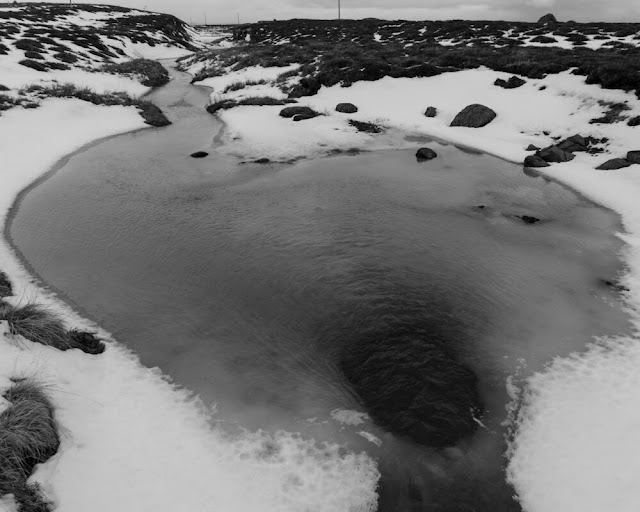Trespasser, Austin, TX, 2024. 88 pp., 47 tritone plates, 11x13½".
— Man Ray
One of my favorites in Robert Adams’s first book of essays, Beauty in Photography, is a piece called “Making Art New.” It’s a funny and playful essay written after paging through the latest copy of Artforum delivered to his front door in rural Colorado. Adams ultimately feels that what defines new, at least by the magazine’s standards, feels a bit like a Sears Roebuck catalog selling the latest washer and dryer set. Contemporary art, Artforum tries to persuade him, is just like the newest mechanical technologies offering experience and luxury unlike anything before it; the latest trends in post-performancism are no different than the magic of this year’s wrinkle guard1. This way of thinking leads Adams to some important questions. What does new mean in art? What is the distinction between new and novel? Shouldn’t art aspire to a truth greater than novelty? Answering these questions, he concludes something different, and that the only “contemporary” that matters in art is whether it speaks to the current situation. Would anybody question that Shakespeare’s insights don’t still reflect on our societies and behaviors today? I do fundamentally agree with Adams; quality in art is not a metric based on technology or appearances but is really about the creator’s ability to reflect on the essential joys and struggles of life, to render truths that seem essential to our being and in a way that evokes empathy from its audience. Perhaps it is easiest to think of it this way: anyone falling in love for the first time is experiencing love as if it has never been experienced before, and thus it is a tale that never grows old.
 |
When I spend time with För, the lovely new publication of photographs by Agnieszka Sosnowska published by Trespasser Books, it is easy for me to imagine the photographer taking similar inspiration from Adams’s essay. För is a laconic book, mostly pictures with very minimal text and presented in a clear and concise manner. The photographs are made with Graflex 4x5 (there are a couple of exceptions), and all in a classical, documentary style. The pictures in För, however, tell a rich story about love and pain, joy and loss, and are executed with emotional clarity and technical precision, rooted in a deeply personal connection to photography. Simply designed photographs made with traditional black-and-white values, Sosnowska demonstrates, can still convey the most essential attributes of being human today, which is ultimately what led me back to Adams. Her approach couldn’t be simpler — photograph the people and places she calls home with an equal affection for her subjects as she has for making photographs. Through the course of För, we see a small selection of people (presumedly family) leading a humble, pastoral life in the stark, harsh tundra of East Iceland. The pictures are simply developed but rigorously seen, and presented with a rich, open, and inviting black-and-white palette. The place she describes is harsh — I can almost feel the biting winds — but also full of warmth and love, days occupied by the beauty of vast landscapes, horses, imaginative children, and warm baths.
 |
 |
Given the minimal information offered in För, I did some inquiry into Sosnowska and learned she was born in Poland and lived most of her early life in Boston before settling in Iceland. The pictures in För are from her current home, or at least as what I understand as such, an unnamed place in East Iceland photographed between 2001-2021. I find this significant because when I look at Sosnowska’s photographs, it’s not only easy for me to see her tattered and highlighted copy of Beauty in Photography somewhere close by, but I can also imagine her as something of an exile, a stranger in a strange land where no place feels totally like home. Herein, I think, is the real impact of Sosnowska’s pictures — clear, affectionate photographs driven by a profound personal emptiness. Throughout För, there is an incredible tension between connection and isolation, a balancing act between loneliness and love.
 |
Implied, I think, in Adams’s conclusions in “Making Art New” is patience. Anybody reading Shakespeare for the first time knows it’s not easy, and you must take the time to really understand his complex understanding of language and storytelling. Thinking of this photographically, I remember Frank Gohlke once telling me that if you make 7 good pictures in a year you should consider it a success. In the age of social media, we’ve totally lost sight of this, but composed over 20-years, För is a brilliant example of what can happen when you think of photographs this meticulously. Towards the end of “Making Art New,” Adams quotes both Man Ray — that idea that making love can only evolve so much — but also shares a lovely idea from American poet Robert Frost: “Poetry is like love. It begins in delight and ends in wisdom.” Any lasting love requires rigor and patience, and in my mind these ideas lead quickly to wisdom and empathy.
Purchase Book
Read More Book Reviews
1. Beauty in Photography was first published in 1981; the cover story in Artforum in October 1981 was “Post-Performancism” by Douglas Davis.
 |
 |
 |
Brian Arnold is a photographer, writer, and translator based in Ithaca, NY. He has taught and exhibited his work around the world and published books, including A History of Photography in Indonesia, with Oxford University Press, Cornell University, Amsterdam University, and Afterhours Books. Brian is a two-time MacDowell Fellow and in 2014 received a grant from the Henry Luce Foundation/American Institute for Indonesian Studies.










